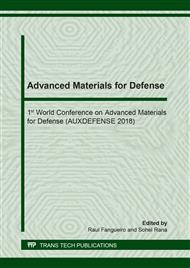[1]
H. Bowerman, G. W. Owens, J. H. Rumley and J. J. A. Tolloczko, Interim Guidance Notes for the Design and Protection of Topside Structures Against Explosion and Fire,, Construction Steel Institute, (1992).
Google Scholar
[2]
API, Recommended Practice for the Design of Offshore Facilities Against Fire and Blast Loading,, American Petroleum Institute, (2006).
Google Scholar
[3]
NORSOK, NORSOK standard N-004, Design of steel structures,, Standards Norway, (2013).
Google Scholar
[4]
DNV, DNV-RP-C204: Design against accidental loads,, Det Norske Veritas, (2010).
DOI: 10.3940/rina.mre.2010.01
Google Scholar
[5]
U.S. Army Corps of Engineers, Naval Facilities Engineering Command and Air Force Civil Engineer Suppor Agency, UFC 3-340-02 Structures to Resist the Effects of Accidental Explosions,, U.S. Department of Defense, (2008).
Google Scholar
[6]
L. A. Louca and J. W. Boh, Research Report 146: Analysis and Design of Profiled Blast Walls,, Health and Safety Executive, London, (2004).
Google Scholar
[7]
B. Erkmen, Comparison of Blast Performance of Steel Modular Buildings with Anchored and Sliding Foundations,, in Proceedings of Eurosteel 2017, Copenhagen, (2017).
DOI: 10.1002/cepa.189
Google Scholar
[8]
G. R. Cowper and P. Symonds, Strain hardening and strain-rate effects in the impact loading of cantilever beams,, Brown University Division of Applied Mathematics, (1957).
DOI: 10.21236/ad0144762
Google Scholar
[9]
G. Johnson and W. Cook, A Constitutive Model and Data for Metals Subjected to Large Strains, High Strain Rates, and High Temperatures,, in Proceedings 7th International Symposium on Ballistics, Hague, (1983).
Google Scholar
[10]
J. Ribeiro, A. Santiago and C. Rigueiro, Damage model calibration and application for S355 steel,, Procedia Structural Integrity, pp.656-663, (2016).
DOI: 10.1016/j.prostr.2016.06.085
Google Scholar
[11]
J. Ribeiro, A. Santiago, C. Rigueiro, P. Barata and M. Veljkovic, Numerical assessment of T-stub component subjected to impact loading,, Engineering Structures, pp.450-460, (2016).
DOI: 10.1016/j.engstruct.2015.10.047
Google Scholar
[12]
Simulia, Abaqus 6.14 Analysis User's Guide, Volume 3: Materials, Dassault Systeme, (2014).
Google Scholar
[13]
CEN, Eurocode 3: Design of steel structures - Part 1-8: Design of joints,, European Committee for Standardization, Brussels, (2005).
Google Scholar
[14]
G. Chen, J. Teng, J. Chen and Q. Xiao, Finite element modeling of debonding failures in FRP-strengthened RC beams: A dynamic approach,, Computers and Structures, pp.167-183, (2015).
DOI: 10.1016/j.compstruc.2015.05.023
Google Scholar
[15]
T. Hughes, Analysis of transient algorithms with particular reference to stability behavior,, in Computational methods for transient analysis, 1983, p.67–153.
Google Scholar
[16]
Simulia, Abaqus 6.14 Analysis User's Guide, Volume 2: Analysis, Dassault Systeme, (2014).
Google Scholar
[17]
API, API 2A WSD,, American Petroleum Institute, (2002).
Google Scholar
[18]
L. Louca and R. Mohamed Ali, Improving the ductile behaviour of offshore topside structures under extreme loads,, Engineering Structures, p.506–521, (2008).
DOI: 10.1016/j.engstruct.2007.04.020
Google Scholar
[19]
R. Alberdi, J. Przywara and K. Khandelwal, Performance evaluation of sandwich panel systems for blast mitigation,, Engineering Structures, vol. 56, (2013).
DOI: 10.1016/j.engstruct.2013.08.021
Google Scholar
[20]
Z. Xue and J. W. Hutchinson, Preliminary assessment of sandwich plates subject to blast loads,, International Journal of Mechanical Sciences, vol. 45, no. 4, pp.687-705, (2003).
DOI: 10.1016/s0020-7403(03)00108-5
Google Scholar
[21]
A. Vaziri and J. W. Hutchinson, Metal sandwich plates subject to intense air shocks,, International Journal of Solids and Structures, vol. 44, no. 6, pp.2021-2035, (2006).
DOI: 10.1016/j.ijsolstr.2006.08.038
Google Scholar
[22]
V. Rubino, V. S. Deshpande and N. A. Fleck, The dynamic response of end-clamped sandwich beams with a Y-frame or corrugated core,, International Journal of Impact Engineering, vol. 35, no. 8, pp.829-844, (2008).
DOI: 10.1016/j.ijimpeng.2007.10.006
Google Scholar
[23]
F. Zhua, L. Zhaoa, G. Lua and Z. Wang, Deformation and failure of blast-loaded metallic sandwich panels—Experimental investigations,, International Journal of Impact Engineering, vol. 35, (2008).
DOI: 10.1016/j.ijimpeng.2007.11.003
Google Scholar
[24]
X. Li, W. Z. Zhang P., G. Wu and L. Zhao, Dynamic behaviour of aluminium honeycomb sandwich panels under air blast: Experiment and numerical analysis,, Composite Structures, vol. 108, pp.1001-1008, (2014).
DOI: 10.1016/j.compstruct.2013.10.034
Google Scholar
[25]
Z. Xue and J. W. Hutchinson, A comparative study of impulse-resistant metal sandwich plates,, International Journal of Impact Engineering, vol. 30, (2003).
Google Scholar
[26]
A. G. Gibson, The cost effective use of fibre reinforced composites offshore,, Health and Safety Executive, (2003).
Google Scholar
[27]
M. Kelly, H. Arora, A. Worley, M. Kaye, P. Del Linz, P. A. Hooper and J. P. Dear, Sandwich Panel Cores for Blast Applications: Materials and Graded Density,, Experimental Mechanics, vol. 56, (2016).
DOI: 10.1007/s11340-015-0058-5
Google Scholar
[28]
H. Arora, P. A. Hooper and J. P. Dear, Dynamic response of full-scale sandwich composite structures subject to air-blast loading,, Composites, vol. 42, (2011).
DOI: 10.1016/j.compositesa.2011.07.018
Google Scholar
[29]
M. R. M. Rejab and W. J. Cantwell, The mechanical behaviour of corrugated-core sandwich panels,, Composites, vol. 47, (2013).
DOI: 10.1016/j.compositesb.2012.10.031
Google Scholar
[30]
A. F. Santos, A. Santiago, L. Simões da Silva, M. Latour and G. Rizzano, Experimental assessment of friction dampers under impact loading,, in Proceedings of Eurosteel 2017, Denmark, (2017).
DOI: 10.1002/cepa.110
Google Scholar
[31]
J. Liao, A Novel Offshore Platform Blast Wall Design With Energy Absorption Mechanism,, The University of Western Australia, (2017).
Google Scholar
[32]
J.-I. Choi, S. M. Hasheminia, H.-J. Chun and J.-C. Park, Failure load prediction of composite bolted joint with clamping force,, Composite Structures, vol. 189, pp.247-255, (2018).
DOI: 10.1016/j.compstruct.2018.01.037
Google Scholar
[33]
B. Mandal and A. Chakrabarti, Numerical failure assessment of multi-bolt FRP composite joints with varying sizes and preloads of bolts,, Composite Structures, vol. 187, pp.169-178, (2018).
DOI: 10.1016/j.compstruct.2017.12.048
Google Scholar


